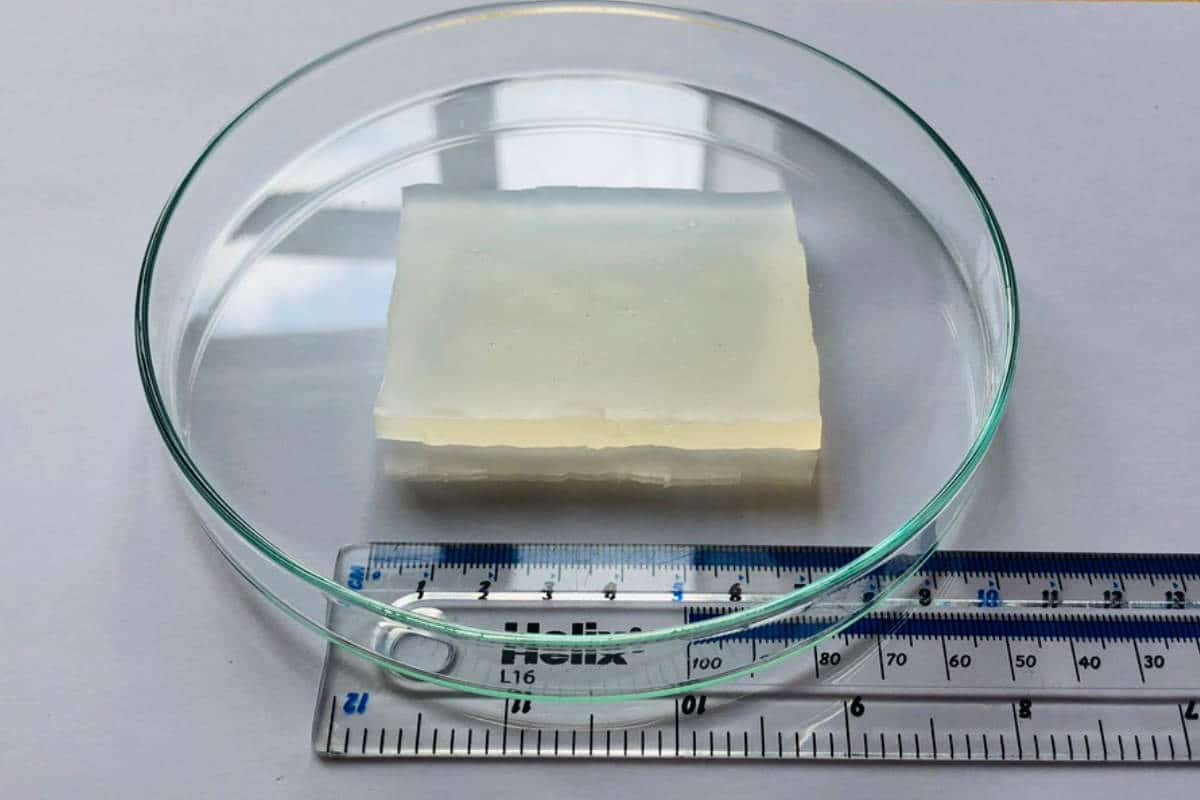
Even though it consists of 80 percent water, the material remains intact even under hundreds of kilograms of weight.
Soft, jelly-like materials consisting mainly of water are often not very strong. “Most are quite brittle,” said researcher Oren Scherman in an interview with Scientias.nl. But in a new study he and his team prove that this is not a fixed fact at all. For example, they developed a very strong ‘blubbery’ material that even an elephant can stand on. “Our fabricated material far exceeds our expectations,” says Scherman.
Hydrogel
In the new study, the researchers developed a hydrogel; a material that often consists of more than 80 percent water. Stretchy and rubbery hydrogels have many great properties that make materials scientists very enthusiastic. Think of their toughness and a self-healing ability. Hydrogels cannot withstand high pressure forces. When a lot of weight is placed on them, such materials are easily crushed.
super jelly
In the new study, however, the researchers succeeded in giving a jelly-like, ‘bubbly’ hydrogel that coveted property. And this ‘super jelly’ as the material has been dubbed can surprisingly take a lot.

super jelly. Image: Zehuan Huang
Although it feels soft and ‘blubby’, it behaves like ultra-hard, shatterproof glass when pressed together. “At 80 percent water content, you’d think it would burst like a water balloon,” says Scherman. “But it isn’t: it remains intact and can withstand enormous compressive forces; qualities that at first glance may seem at odds with each other.”
Elephant
The super jelly could even be the weight of an elephant, the researchers claim. Although they did not have an elephant available during their experiments, they decided to drive over the hydrogel a few times with a 1200 kilo car (see also the video below). The super jelly did not flinch. After refurbishment, it fully recovered to its original shape. “This is the first time we’ve made such a strong material that doesn’t explode upon compression,” says Scherman.
Watch the super jelly being run over by a car in this video.
How?
How did the researchers manage this? “The key to making this super jelly is simple,” the researcher begins. “Slow means strong. First, we drastically slow down the molecular interactions in the material, giving us access to a new kind of state in a hydrogel for the first time.” The researchers used so-called ‘crosslinkers’; a compound that links two polymer chains together. In this case, barrel-shaped molecules called cucurbiturilen served as crosslinkers. These actually act like molecular handcuffs, keeping the other two molecules neatly in place. This ensures that the entire polymer network remains tightly connected. And that makes it resistant to compression.
Important
Developing such strong materials is not just for fun. It also serves a certain purpose, according to Scherman. “Tissues in our body are also very similar to ‘jelly’,” he says. “We also mainly consist of water. At the same time, some of our fabrics are very strong. Articular cartilage, for example, can withstand high compressive forces. The development of super strong gelatinous materials is therefore of crucial importance for the counterfeiting of such fabrics. It may eventually even replace cartilage.”
Other applications
Although it is of course fascinating that in the future a kind of ‘super jelly’ could take over the task of cartilage, the material has other applications, according to the researcher. “We envision that the super jelly could be useful in arm or leg prosthetics,” he says. “It could also be used in soft robotics or bioelectronics.”
The super jelly is a big step forward. “People have been making rubbery hydrogels for years, but that’s only half the picture,” says Scherman. “We’ve revisited traditional polymer physics and created a new class of materials that spans the range of material properties – from rubbery to glassy – and now completes the picture. The study will therefore create a new paradigm in polymer science, materials science and biomedical engineering.”
Source material:
“‘Super jelly’ can survive being run over by a car” – University of Cambridge
Interview with Oren Scherman
Image at the top of this article: Zehuan Huang